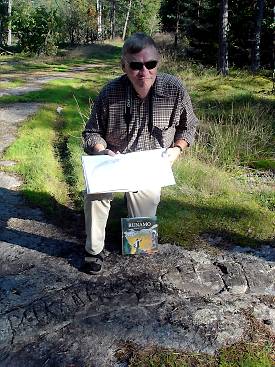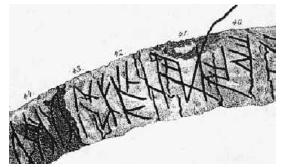Reading Runes at Runamo March 25, 2011
Author: Beach Combing | in : Medieval, Modern , trackbackThe horror! The horror! Beachcombing joined the rest of his family this morning with headlice and so is rushing this post in between a delousing shower and the preparation of an application for a new job for Mrs B. Apologies too to all those many correspondents to whom he has not yet replied. He hopes to catch up over this weekend. This is the last really horribly busy week of term and then it is all downhill to a summer full of writing, pistachio nuts and visits to the swings. Oh happy days!
Anyway for now on to the extraordinary story of intellectual perversion behind Beachcombing’s all time favourite rogue-researcher: Finn Magnussen (obit 1847 – Finnur Magnusson in Icelandic). FM was a first rate Icelandic scholar who brought science to the study of Norse literature and translated, among others, the Elder Edda. Indeed, what follows is for Beachcombing not primarily the study of FM’s folly but of a universal and all too understandable human weakness among past-loving historians: the ability to see things that are not there.
In 1833 FM led a group of scholars on behalf of the Royal Danish Academy to visit the famous runes of Runamo (Blekinge Sweden). These runes – the Serpent of Harald – first appear in history in the twelfth century when Saxo Grammaticus described how they were already at that date illegible: they run across a horizontal pathway of granite (see picture).
However, this was the early nineteenth century and with that can-do mentality that has long since migrated from Europe to the Americas FM and friends put their minds to the mystery.
July 14 workers were sent in to remove the grass so the experts could get at the runes. Men with doctorates never got their hands dirty back then. Oh no, sir! Then a geologist was sent to examine the marks because there were some footling worries that the runes may have been caused by erosion in some places!! The geologist chalked in the natural runes – though he was not able to read runes (ahem!) – and then the group artist sketched these out for FM.
Almost two hundred years later we can imagine the excitement as Magnusson set to work. Yet he was immediately faced with disappointment. The long strip of runes were, in no way, legible: even though he tried and tried again for a year. Then one fine morning…
I had the sudden impulse to read the inscriptions backwards or from right to left. Immediately I could read the word hiiltekinn (hildekinn or hyldekinn) and the other words could then soon be read without much difficulty, according to the rules by which one would read in Iceland (and other countries) of olden times, and partly from how one usually makes sense of the so-called bind runes (complex or intertwined runes). One after another I wrote down the words. I discovered with the exception of the first words, written in Old Norse, that they made up regular, yes even alliterative verse completely in accordance with the existing rules of the so-called Fornyðalag (the verse of the antique age also known as starkaðarlag), and were probably the song the great bard is said to have composed of the battle at Bråvalla, in which Harald Hildetand ended his days. (translation Rix)
It was naturally the climax of Magnussen’s career and to Beachcombing’s mind the scald that FM found on the rock vein is one of the finest to have been passed down to us. Certainly the academies and newspapers of Europe thought so and praise was heaped on the northern scholar.
Hildekind conquered (received) the Riches (the Kingdoms – the Government),
Gard carved (the Runes)
Ole gave Oath (swore an Oath of Loyalty)
Odin blessed (or consecrated) the Runes!
(Hope) Ring must fall to ground! [fall in battle]
Elves, Deities of Love
Ole (hate, despise, abandon)!
Odin and Freyr
And the Lineage of Aesir
Destroy, destroy
Our enemies!
Grant Harald
A great Victory. (translation Rix)
Now, however, Beachcombing has to bring out the sledgehammer he’s been hiding under his keyboard. The problem was that Saxo Grammaticus had been wrong all those centuries before. The ‘runes’ of Runamo – Runamo itself means the ‘Cliff of Runes’ – were nothing more than erosion marks.
Indeed, geologists swarmed into the area and proved this by taking chisels to the ‘runes’ (!) and showing that the cuts were too deep for a runic carver and that they appeared in relation to the pressure put on the path by passing carts. Harald’s Serpent was, damn it, nothing more than a dolerite dike with cracks.
Poor old FM – who was clearly an honest man – found himself in disgrace and with a couple of other misinterpretations to his name, including a misreading of the Ruthwell Cross and some North American ‘runes’ (!) his life spiralled down to divorce, death and rune (get it?).
Still let’s hope he didn’t have headlice…
Beachcombing loves to collect stories of scholars seeing things that are not actually there: drbeachcombing AT yahoo DOT com
If Beachcombing survives the insecticide he’ll be back at this time tomorrow.




